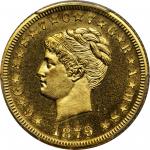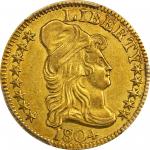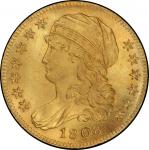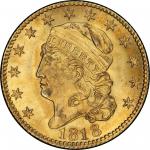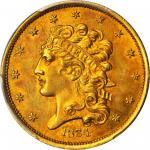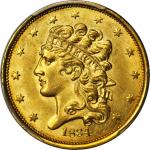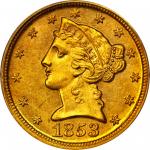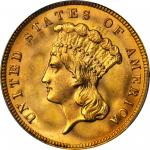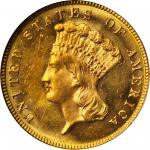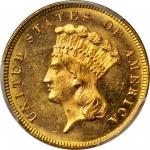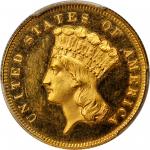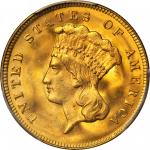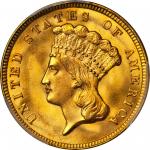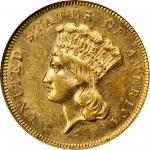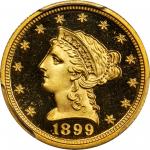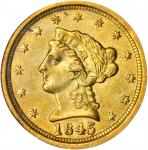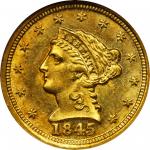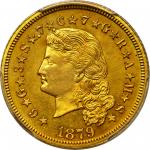1879 Four-Dollar Gold Stella. Flowing Hair. Judd-1635, Pollock-1833. Rarity-3. Gold. Reeded Edge. Proof-64 (PCGS). Secure Holder.Vivid honey-gold hues complement the dazzling surfaces of this near-Gem Flowing Hair Stella. The fields are watery and pleasantly reflective, subtly contrasting the more frosted design elements throughout. A few light wisps of cabinet friction are spotted under magnification, though the complexion is otherwise serene and fully composed to the naked eye. With strong technical qualities to match a gorgeous aesthetic, this piece is surely destined for an exceptional cabinet. The story of the four-dollar Stella begins in Europe in 1865 with the establishment of the Latin Monetary Union in which several of the major economic powers of their day established a unified monetary standard. This economic union, which lasted officially until 1927 and was a predecessor of todays EU, allowed gold and silver coins of many nations to circulate freely at the same weight and purity standard, easing commerce within Continental Europe. American travellers abroad noted the ease of currency exchange within the union, as well as the comparative difficulty in converting American coins. These challenges prompted several attempts to make the American gold coinage system conform more closely to the standards of the Latin Monetary Union. One attempt in 1874 went so far as to produce a few pattern coins based on a proposal by Dana Bickford, but otherwise it did not progress much beyond the concept phase.In 1879, another proposal gained significant momentum when John A. Kasson, the United States minister plenipotentiary to the Austro-Hungarian Empire and a former chairman of the Congressional Committee on Coinage, Weights and Measures, suggested the creation of a $4 gold coin to facilitate trade abroad. The $4 coin would be closer in weight to the most popular European gold coins then in circulation, in particular the Austro-Hungarian 8 florin piece, a coin with which Kasson was most familiar. The proposed new denomination would be minted in a metric gold alloy of 85.71% gold, 4.29% silver and 10.00% copper, based in part on a similar silver alloy called "goloid" patented by Wheeler W. Hubbell of Pennsylvania. The proposal was referred to the current Coinage Committee chairman, Alexander Stephens, who then wrote to Secretary of the Treasury John Sherman requesting that the Mint prepare patterns of the denomination for Congressional evaluation. Two designs were prepared, the Flowing Hair design by Charles E. Barber, as here, and the Coiled Hair design by George T. Morgan (the attribution of the portraits is by numismatic tradition only, as no original archival information or documentation has been found regarding the authorship of the motifs). While the obverse legend states the weight and composition of the goloid alloy intended for regular issue production, the patterns were made of the statutory 90% gold, 10% copper alloy. Per the website <em>uspatterns.com</em>, the Mint used shaved half eagle planchets to produce the four-dollar Stella patterns. The process by which the half eagle planchets were shaved imparted the striations that are more or less evident on most Stellas, generally on the high points of the obverse portrait and reverse star. The proposed new name for the denomination, Stella, was based "in analogy to one eagle, both the star and eagle being national emblems on our coins."The Barber Flowing Hair design was selected initially and 25 (and possibly as few as 10 or 15) three-piece pattern Proof sets were prepared for distribution to Congressional leaders. The coins proved to be popular among government officials and the resultant demand for additional specimens was so great that the Mint was obliged to strike several hundred more examples in 1880, all bearing the 1879 date. Estimates of production figures for the 1879 Flowing Hair type range from the traditional figure of 425 coins to as many as 800 pieces suggested by some modern researchers. Walter Breen initially classified the production in two categories, originals and restrikes, though there has not been a definitive way of distinguishing between the two. In the end, the proposed denomination failed to garner enough support to be authorized and was never put into production.While never issued for circulation and by all definitions a pattern coin, the Stellas inclusion over the years in the <em>Guide Book</em> has made the denomination an essential part of a complete gold type set. Today, most Stellas are found either impaired or well preserved. Many appear to have ended up as jewelry or as pocket pieces, with some apocryphal accounts even placing these worn coins in the hands of proprietors of Washingtons many "houses of ill repute," though this claim has not been reasonably proven. Others were clearly well cared-for, such as the present piece, and have become cherished mementos. The addition of a Stella to ones numismatic holdings has always been a crowning achievement.

